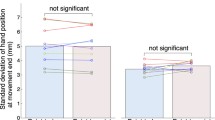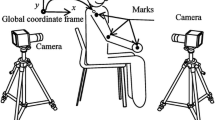Abstract.
Six subjects performed a planar reaching arm movement to a target while unpredictable perturbations were applied to the endpoint; the perturbations consisted of pulling springs having different stiffness. Two conditions were applied; in the first, subjects had to reach for the target despite the perturbation, in the second condition, the subjects were asked to not correct the motion as a perturbation was applied. We analyzed the kinematics profiles of the three arm segments and, by means of inverse dynamics, calculated the joint torques. The framework of the equilibrium-point (EP) hypothesis, the λ model, allowed the reconstruction of the control variables, the “equilibrium trajectories”, in the “do not correct” condition for the wrist and the elbow joints as well as for the end point final position, while for the other condition, the reconstruction was less reliable. The findings support and extend to a multiple-joint planar movement, the paradigm of the EP hypothesis along with the “do not correct” instruction.
Similar content being viewed by others
Author information
Authors and Affiliations
Additional information
Received: 3 May 1999 / Accepted in revised form: 19 May 2000
Rights and permissions
About this article
Cite this article
Cesari, P., Shiratori, T., Olivato, P. et al. Analysis of kinematically redundant reaching movements using the equilibrium-point hypothesis. Biol Cybern 84, 217–226 (2001). https://doi.org/10.1007/s004220000186
Issue Date:
DOI: https://doi.org/10.1007/s004220000186




